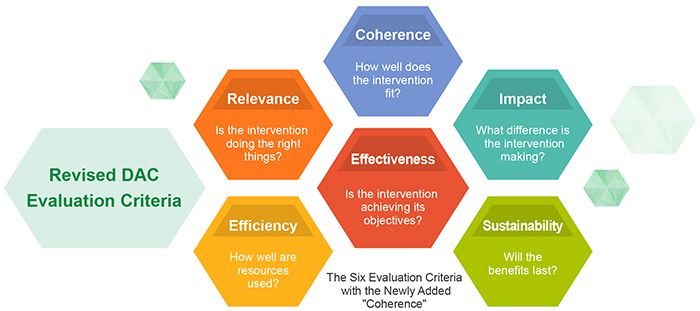Column
New Criteria for ODA Evaluations
In evaluating ODA, evaluators refer to certain standards to judge its effectiveness. However, it is not generally known what sort of standards evaluators rely on.
In December 2019, the Development Assistance Committee (DAC) of the Organisation for Economic Co-operation and Development (OECD) adopted a new set of international criteria for ODA evaluations. The adoption of the new DAC Evaluation Criteria followed two years of discussion at the Network on Development Evaluation (EvalNet), a subsidiary body of the DAC. Under the leadership of Norway as the Chair, the member countries and international organizations of EvalNet, including Belgium and the World Bank, participated in these negotiations. Japan also played an important role as the Vice-Chair of the network.
For the first time in almost 30 years, the five evaluation criteria, which had served as the international standards for ODA evaluations since 1991, have been revised in order to better reflect the principles of the 2030 Agenda for Sustainable Development. In addition to "Relevance," "Effectiveness," "Efficiency," "Impact" and "Sustainability," "Coherence" was added as a new criterion. Coherence consists of "Internal Coherence" and "External Coherence." Internal Coherence focuses on coherence within a donor institution and analyzes whether its interventions are interlinked and generate synergy effects or whether they are coherent with policies other than development (e.g., humanitarian assistance, and education policies). External Coherence considers the consistency of the intervention with other actors' interventions and analyzes whether coordination is undertaken to avoid duplication.
The definitions of the original five criteria were also updated, incorporating more clearly the perspectives of the 2030 Agenda, including whether the intervention ensures equity (including gender equality) or whether a project is environment-friendly and sustainable. Furthermore, one of the key features of the revision is that the new Evaluation Criteria clarify that a broad range of development and humanitarian activities and instruments, including development aid, humanitarian assistance, peace-building efforts or private sector instruments, are subject to evaluation.
In response to the new DAC Evaluation Criteria, MOFA revised its ODA Evaluation Guidelines in June 2020. The latest version of these guidelines reflects the new criteria of Coherence by ensuring that the Relevance of Policies checks the consistency of the intervention in relation to not only development policies, but also humanitarian assistance and other policies, and that Effectiveness of Results considers the effects of the intervention on various beneficiary groups in terms of gender, ethnicity and other perspectives. It also makes clear that environmental sustainability should be considered when analyzing the effects of the intervention.
As outlined above, the international criteria for ODA evaluations have been updated to reflect the priorities of the international community. MOFA will strive to work on ODA evaluations by raising awareness of important challenges to achieve sustainable development and recognizing the importance of asking what sort of development impact Japan's ODA has had and whether Japan's ODA is suitable for creating a society in which no one will be left behind.

The Six Evaluation Criteria with the Newly Added "Coherence"
